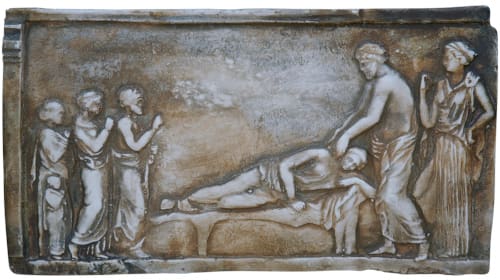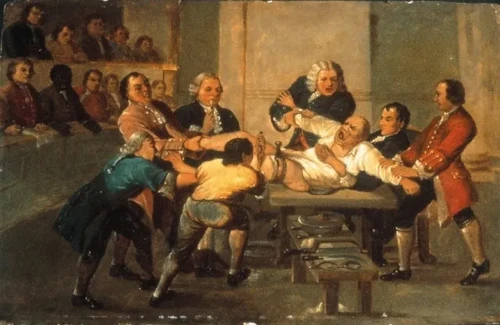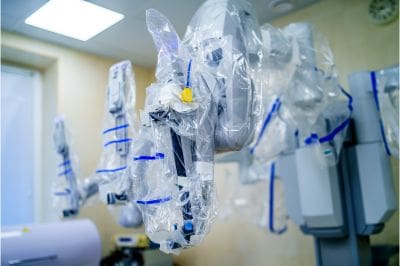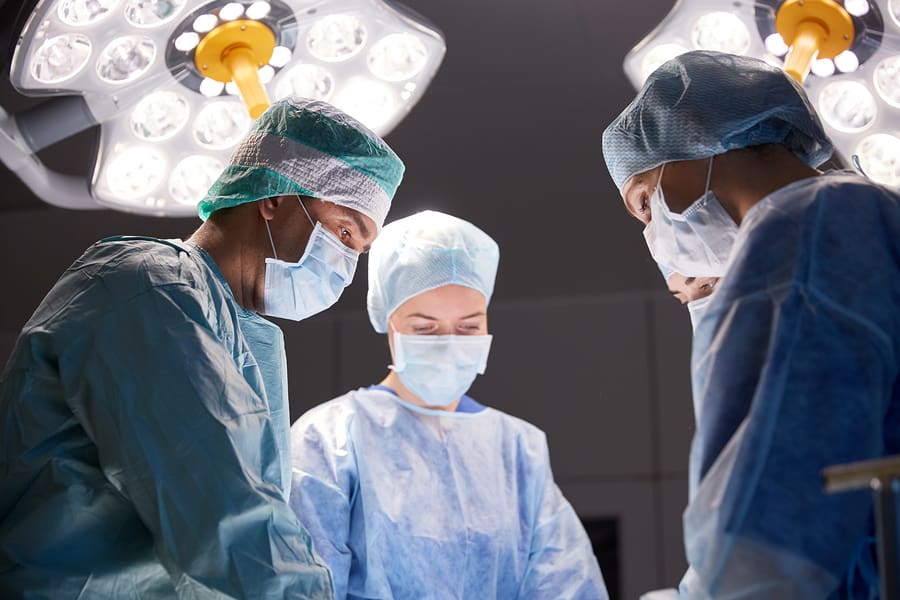Surgery has come a long way from its early roots, evolving through centuries of practice, innovation, and discovery. In ancient times, surgery was often a blend of medical knowledge and mysticism, with the earliest surgical procedures being performed by priests and healers. These procedures were rudimentary and risky, limited by the lack of understanding of human anatomy and the absence of anesthesia and sterilization. Instruments used were basic and crude, such as sharpened stones and needles made of bone.
As civilizations advanced, so did surgical practices. The ancient Greeks and Romans made significant contributions to the field, including the development of specialized surgical instruments and the establishment of the first guidelines for surgical hygiene. However, it wasn’t until the Renaissance that surgery began to resemble a modern science. This period saw an explosion in anatomical knowledge, thanks largely to the work of pioneering surgeons and anatomists who challenged existing doctrines and conducted detailed dissections.
The transformation from these early practices to today’s advanced surgical procedures is nothing short of remarkable. The leap from sharpened stones to precision robots represents thousands of years of human ingenuity and the relentless pursuit of better medical outcomes. Today, surgery is a sophisticated discipline that combines the skills of highly trained professionals with cutting-edge technology to save lives and improve the quality of life for countless individuals. As we delve into the modern age of surgical technology, it’s essential to appreciate the journey that brought us here, shaping the intricate interplay between human skill and technological advancement in the quest to heal.
A Brief History of Surgery
The history of surgery is a testament to humanity’s enduring quest to heal and understand the human body. Its origins trace back to the Stone Age, where evidence of trephination, the act of drilling holes into the skull, suggests an early attempt to treat head injuries or relieve pressure. Despite the rudimentary nature of these procedures, they mark the beginning of surgical intervention. As civilizations grew, so did the complexity of surgical practices. Ancient Egyptians, for example, were known to have practiced basic surgery as documented in the Edwin Smith Papyrus, which describes surgical treatment for various injuries and ailments, showcasing a surprisingly advanced understanding of the human body for its time.
Surgery in the Classical Age
The Greeks further advanced surgery, with Hippocrates, often referred to as the “Father of Medicine,” establishing ethical standards for medical practice and emphasizing the importance of understanding anatomy. However, it was during the Roman Empire that surgical tools and techniques saw significant development, including the use of specialized instruments like forceps and catheters, and the practice of cataract surgery.

Advances Through the Middle Ages
The Middle Ages brought a stagnation to surgical advancements in Europe due to the suppression of scientific exploration, but the Islamic Golden Age kept the flame of medical knowledge alive. Scholars like Al-Zahrawi, often considered the father of modern surgery, made remarkable contributions, including the development of over 200 surgical instruments.

Big Steps in the Renaissance
Surgical practice took a giant leap forward in the Renaissance, fueled by a renewed interest in human anatomy and dissection. This period saw figures like Andreas Vesalius challenge prevailing anatomical inaccuracies, laying the groundwork for modern anatomy. However, it wasn’t until the 19th century, with the introduction of anesthesia and antiseptic practices by pioneers such as Joseph Lister and the discovery of ether, that surgery could truly evolve into the safer, more effective discipline it is today. These breakthroughs dramatically reduced the risks associated with surgical procedures, paving the way for the rapid advancements in the 20th and 21st centuries, including minimally invasive techniques and the integration of robotic technology, which have revolutionized surgical practice and patient care.
Traditional Surgical Implements and Techniques
Before the advent of modern technology, traditional surgical implements and techniques were the backbone of surgical practice. These tools and methods, although primitive by today’s standards, laid the foundation for contemporary surgery.
Essential Surgical Implements
The basic surgical toolkit included instruments like scalpels, made initially from flint and later from steel, which were used for cutting. Forceps for gripping or holding tissues, scissors for cutting softer tissues, and needles for suturing wounds were also essential. Additionally, specialized tools like trephines, a type of surgical drill, were developed for specific procedures like trephination.
Traditional Techniques and Challenges
Beyond these implements, traditional techniques were heavily reliant on the surgeon’s skill, knowledge, and manual dexterity. Surgical procedures were often performed without any form of pain relief until the discovery of anesthesia in the mid-19th century. This limitation meant surgeries had to be quick to minimize patient distress, leading to a focus on speed and efficiency. The absence of sterilization techniques also meant that post-operative infections were common, significantly impacting patient outcomes.
The Role of Surgical Technicians in Traditional Surgery
The role and training of surgical technicians, or the lack thereof, in these times were vastly different from today. Initially, surgical tasks were performed by the surgeon with the assistance of apprentices or less skilled workers who had little to no formal training. These assistants were responsible for tasks like holding instruments, managing lighting, and restraining patients during procedures. As medical knowledge expanded, the importance of a more skilled supporting role in surgery became apparent, leading to the formalization of surgical assistant roles and the development of specific training programs for these critical support staff.
Despite the limitations, traditional surgical techniques and instruments were instrumental in advancing the field of surgery. Innovations and improvements in these tools and methods over centuries have paved the way for the development of modern surgical practices, emphasizing the importance of understanding this history to appreciate the advancements in patient care and surgical outcomes.

Transition to Modern Surgical Technologies
The transition to modern surgical technologies marks a pivotal period in the history of medicine, characterized by rapid advancements and innovations that have fundamentally transformed surgical practice. This shift was driven by a combination of scientific discoveries, technological breakthroughs, and a deepening understanding of human anatomy and physiology. The journey from traditional to modern surgical techniques is a testament to human ingenuity and the relentless pursuit of improved patient care.
The Advent of Anesthesia and Antiseptics
The introduction of anesthesia in the mid-19th century was a watershed moment in surgery. For the first time, patients could undergo procedures without the agony of feeling every incision. This discovery not only expanded the possibilities for surgical procedures but also allowed surgeons to perform more intricate and longer surgeries, as patient movement and pain were no longer limiting factors.
Equally transformative was the development of antiseptic techniques by Joseph Lister in the late 19th century. By applying Louis Pasteur’s germ theory, Lister demonstrated that sterilizing surgical instruments and cleaning wounds with carbolic acid drastically reduced post-operative infections. This practice laid the groundwork for modern aseptic techniques, including the use of gloves, gowns, and sterile environments, which are fundamental to surgery today.
The Rise of Surgical Specialization
As knowledge and technology advanced, so did the complexity of surgical procedures. This complexity necessitated a shift towards specialization, with surgeons focusing on specific areas of the body or types of surgery. Specialties such as orthopedics, neurosurgery, and cardiovascular surgery emerged, each benefiting from specialized tools, techniques, and a deeper understanding of the related anatomy.

Technological Innovations
The 20th and 21st centuries have seen an explosion of technological innovations in surgery. The development of minimally invasive techniques, such as laparoscopic surgery, has significantly reduced recovery times and the risk of complications. Surgical robotics, epitomized by systems like the da Vinci Surgical System, have enhanced precision and allowed for even less invasive procedures. Furthermore, advancements in imaging technology, such as MRI and CT scans, have improved diagnostic accuracy and surgical planning.
The Integration of Digital Technology
The digital revolution has also made its mark on surgery. Digital records and telemedicine have improved the efficiency and accessibility of surgical care. Simultaneously, virtual reality (VR) and augmented reality (AR) technologies have emerged as powerful tools for surgical training and planning, allowing surgeons to practice procedures in a risk-free environment and visualize complex surgeries before making the first incision.
The transition to modern surgical technologies has not only revolutionized how surgeries are performed but has also significantly improved patient outcomes and safety. This era of rapid innovation continues to push the boundaries of what is possible in surgery, promising even more remarkable advancements in the years to come.
The Future of Surgical Technology
As we gaze into the horizon of surgical technology, it’s clear that the field is on the brink of further groundbreaking advancements. These future technologies promise to enhance surgical precision, improve patient outcomes, and even redefine the very nature of surgery. Here are some key areas where we can expect significant developments:
- Enhanced Robotic Systems
Robotic assistance in surgery is set to become more sophisticated and integrated. Future generations of surgical robots will feature enhanced dexterity, allowing for a broader range of procedures, including those requiring extremely delicate manipulation. Additionally, advancements in artificial intelligence (AI) will enable these robots to learn from each surgery, improving their efficiency and reducing the potential for human error.

- Augmented Reality and Virtual Reality
Augmented Reality (AR) and Virtual Reality (VR) will play increasingly pivotal roles in both surgical training and the operating room. Surgeons could use AR to overlay critical information, such as real-time vital signs or imaging data, directly onto their field of view during procedures. Meanwhile, VR will continue to evolve as a training tool, providing highly realistic simulations that can replicate the unpredictability of real-life surgeries.
- Regenerative Medicine and Bioprinting
The future of surgery will not just be about cutting and repairing but also about regenerating and reconstructing. Advances in regenerative medicine, fueled by stem cell research and bioprinting, could allow for the repair or even regeneration of damaged tissues and organs in situ, potentially reducing the need for invasive procedures and transplants.
- Nanotechnology
Nanotechnology holds the promise of revolutionizing surgery through the development of nanobots capable of performing tasks at a cellular level. These microscopic robots could deliver targeted drug therapies, repair tissue damage, or clear blockages in blood vessels, all without the need for traditional surgery.
- Telemedicine and Remote Surgery
Telemedicine has already begun to expand access to surgical consultations and follow-up care. In the future, advancements in communication technologies and robotic precision could enable remote surgery to become more commonplace, allowing top surgeons to perform procedures from across the globe, ensuring expert care is accessible to all, regardless of location.
- Personalized and Precision Surgery
The integration of genomics and personalized medicine into surgical practice will allow for more tailored surgical interventions. By understanding a patient’s genetic makeup, surgeons will be able to predict responses to certain surgical interventions, customize procedures to minimize risks, and enhance recovery outcomes.
The Ethical and Practical Challenges
With these advancements come ethical and practical challenges that will need to be addressed. Issues such as patient privacy, data security, and the equitable distribution of high-tech surgical solutions will be at the forefront. Moreover, the role of the surgeon will continue to evolve, requiring ongoing education and adaptation to new technologies.
The future of surgical technology is bright, with innovations that promise to transform the landscape of healthcare and surgery. As we move forward, the focus will remain on enhancing patient care, reducing risks, and embracing the potential of technology to heal and improve lives.
The Journey of Surgical Technology

As we conclude our exploration of surgical technology in the modern age, it’s clear that the field has undergone a remarkable evolution. From the rudimentary tools and techniques of ancient times to the sophisticated robotics and digital innovations of today, surgery has consistently pushed the boundaries of what’s medically possible. This journey is not just a testament to technological advancement but also to the human spirit’s relentless pursuit of better ways to heal and save lives.
The future holds even more promise, with emerging technologies poised to further revolutionize surgical practices. However, as we embrace these new possibilities, it’s crucial to remember the core principles that have guided surgery through the ages: a commitment to patient care, the importance of skilled human judgment, and the ethical use of technology. The balance between innovation and these timeless values will be key to ensuring that advancements in surgical technology continue to serve the best interests of patients around the world.
Moreover, the role of surgical technicians and other support staff will continue to evolve, highlighting the importance of teamwork and interdisciplinary collaboration in the operating room. As technology advances, so too must our approaches to education, training, and professional development, ensuring that all members of the surgical team are equipped to utilize these new tools effectively.
The journey of surgical technology from its earliest days to the modern era—and beyond—is a powerful reminder of how far we’ve come and how much further we can go. By harnessing the power of innovation while staying grounded in the principles of good medical practice, we can look forward to a future where surgery is safer, more effective, and accessible to all who need it. The story of surgical technology is still being written, and each new chapter promises to be as exciting and impactful as the last.

